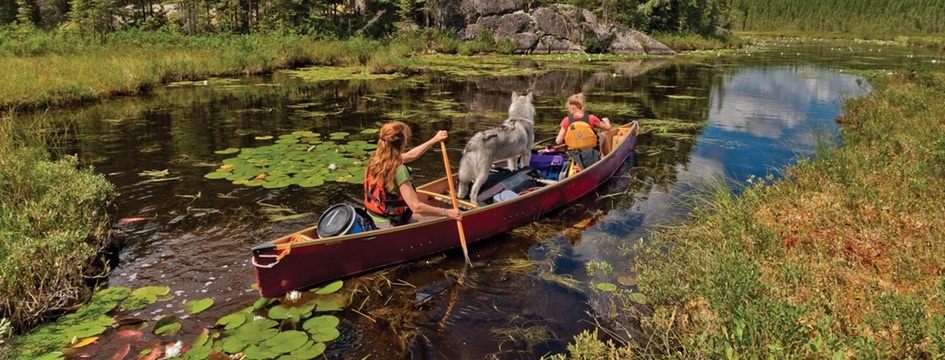How to Choose A Canoe
One of the distinguishing benefits of canoes is their capacity to seat a few passengers and carry a lot of gear. There are different canoe styles for every situation and every type of water condition. The kind of canoe, material and what size it needs to be, will be determined by how you are going to use it. Once you determine where and how you will be paddling, it will narrow down the kind of canoe you're looking for. All canoes will have standard features like gunwales, seats, a thwart and a yoke. All canoes and their features are available in a wide range of materials and colours. A general rule to remember is: the wider the canoe the more stable and slower it will be. While the longer and narrower the canoe, the more efficient and faster it will be.
Recreational / Family
A recreational family canoe is for someone who wants to get on the water with family, friends and their dog, and whose main concern is stability. The optimal length for a recreational family canoe is usually 16 or 17 feet to accommodate two paddlers, with the option of adding a third paddler in the middle. If you will only ever have two paddlers a 15ft canoe will work as well, but you won’t be able to carry as much gear. The common materials for recreational canoes are usually plastic or fiberglass, which tend to be on the heavier side because of their durability. Keep in mind these kinds of materials usually range from 70 - 90 lbs. The wider and deeper the canoe the less tippy it will feel - perfect for a relaxed few hours on the water.
Tripping
If you plan on paddling for more than a few hours and want to go on some weekend getaways and longer trips, there are a few things to consider for this type of canoe: tracking, capacity and material weight. For a canoe to track well, it needs two characteristics: length and less rocker. A longer canoe with little rocker will track better and greater carrying capacity. The better the canoe tracks, the easier it will be to keep straight, which will mean the faster you can get to where you are going with efficiency and ease. The kind of material this paddler will want will depend if they are leaning towards durability or speed. For durability T-Formex is a go to material and ranges from 60 - 70 lbs depending in the length. If you want something that is easier to lift and carry, and will be faster on the water, materials like Kevlar and Carbon are the best options, ranging from 45 - 60 lbs, again depending on length. For something in the middle of durability and weight, there is fiberglass. Tripping canoes are perfect for carrying lots of gear for those weekend trips or longer expeditions.
Whitewater
For the more adventurous, there are always rapids! If a longer canoe helps you track, then a shorter canoe with lots of rocker has more agility and maneuverability, which is the main characteristic you want when navigating through rock gardens! Tracking, speed and weight are often secondary to agility and durability. You’ll want a high rocker and a short length canoe so you can turn on a dime in a moment's notice. Plastic or T-Formex are go to materials in this category because of their ability to withstand impacts and still keep trucking. These canoes are solo canoes with little to no gear carrying capacity. With tons of agility and maneuverability these canoes are a blast while running rapids.
Freighter
Going hunting for deer or moose or hauling lots of gear? You’ll need a large canoe that has a huge carrying capacity. That’s where freighter canoes come in. Ranging from 15 - 19 feet, these beasts are super wide to give stability when transporting heavy loads. Depending on the length and model they will have up to 4 rows of seats, with the option to mount a motor. Because freighter canoes are predominantly used for hunting they often have a camouflage colour option. These canoes are extremely wide so they aren’t the most graceful or efficient, but they are perfect hauling heavy loads for your next hunting trip.
Solo
For the canoeing enthusiast who really wants to get away, solo canoes are for the real solitary souls. Since the paddler will be paddling alone, most solo canoes only have one seat and are typically shorter than tripping canoes. You also have the option of using a kayak paddle. These canoes are shorter so a single paddler can handle the canoe easily in all types of water and conditions. If you are racing you will want a longer boat, but if you are simply going on a leisure paddle, a medium length boat of 14 - 16 ft would be perfect. Depending on where and how you will be paddling will determine the material you will want.

